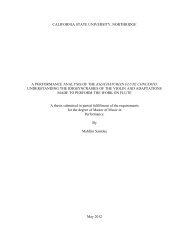Page 1 The California ""- Geographer Annual Publication of the ...
Page 1 The California ""- Geographer Annual Publication of the ...
Page 1 The California ""- Geographer Annual Publication of the ...
Create successful ePaper yourself
Turn your PDF publications into a flip-book with our unique Google optimized e-Paper software.
Mean Monthly Temperatures (in F. o) for Twin Lakes and Ellery Lake<br />
(based on 1931 through 1952 period)<br />
Jan. Feb. Mar. Apr. May June July Aug. Sept. Oct. Nov. Dec. Year<br />
Twin Lakes 23.7 24.9 28.6 35.3 41.0 48.2 56.0 55.9 50.6 41.7 33.4 27.3 38.8<br />
Ellery Lake 23.2 22.6 26.8 32.2 38.8 46.2 55.0 54.7 48.7 39.0 31.0 25.0 36.9<br />
Table 5<br />
In o<strong>the</strong>r areas that are mapped as Dsc <strong>the</strong>re are no climatic stations,<br />
or ones with very short records, but with <strong>the</strong> information obtained from<br />
<strong>the</strong> four stations n1entioned above, and ones in key areas with short periods<br />
<strong>of</strong> record, criteria <strong>of</strong> a certain altitude combined with <strong>the</strong> typical vegetation<br />
found in <strong>the</strong> o<strong>the</strong>r Dsc areas nearby were used to complete <strong>the</strong>se regions<br />
on Figure l.<br />
When drawing <strong>the</strong> climatic map an attempt was made to avoid<br />
classifying individual mountain peaks. However, in a few instances this<br />
was impossible, because <strong>the</strong> mountain was such an outstanding landmark.<br />
This reference is to Mount Shasta and Mount Lassen in Nor<strong>the</strong>rn <strong>California</strong><br />
which have some EH and Dsc climates, and Mount San Jacinto<br />
(\iVest <strong>of</strong> Palm Springs) in Sou<strong>the</strong>rn <strong>California</strong>, which has Dsc climate in<br />
its higher reaches. In most o<strong>the</strong>r cases, only mountain ranges, some <strong>of</strong> <strong>the</strong>m<br />
admittedly not large in area, but very much dissimilar to <strong>the</strong>ir surroundings,<br />
were classified differently than <strong>the</strong> surrounding area if that was found<br />
to be <strong>the</strong> case. An example would be <strong>the</strong> White Mountains <strong>of</strong> east central<br />
<strong>California</strong>. Two complete wea<strong>the</strong>r stations were established here in September<br />
1955, by <strong>the</strong> University <strong>of</strong> <strong>California</strong> and <strong>the</strong> U.S. Navy in conjunction<br />
with <strong>the</strong> U.S. Wea<strong>the</strong>r Bureau. One <strong>of</strong> <strong>the</strong>se, White Mountain<br />
#1, was mentioned earlier as being in one <strong>of</strong> Dsc regions <strong>of</strong> <strong>California</strong>.<br />
<strong>The</strong> o<strong>the</strong>r, White Mountain #2 is almost 2,500 feet higher than #1, and<br />
at an elevation <strong>of</strong> 12,470 feet is <strong>the</strong> highest complete wea<strong>the</strong>r station in<br />
<strong>the</strong> United States.10 Being at such a high altitude White Mountain #2<br />
easily qualifies for <strong>the</strong> ET climate as set up bv Koppen. In this case it is<br />
not adjacent to <strong>the</strong> polar regions, but in middle latitudes, so we use Koppen's<br />
highland symbol for this Hekisto<strong>the</strong>rmal area, EH. Table 6 lists<br />
pertinent temperature data for White Mountain #2.<br />
Temperature Data for VVhite Mountain #2, <strong>California</strong> (in F. 0)<br />
(based on <strong>the</strong> 8-year period 1956 through 1963)<br />
Jan. Feb. Mar. Apr. May June July Aug. Sept. Oct. Nov. Dec. Year<br />
Mean<br />
Maximum 22.1 21.6 22.8 29.5 34.2 46.1 53.0 52.4 47.3 37.3 30.8 28.4 35.5<br />
Minimum<br />
Mean 8.1 6.7 6.8 12.6 18.3 29.6 35.8 35.3 30.3 21.8 15.0 12.2 19.4<br />
Mean<br />
Monthly 15.1 14.2 14.8 21.0 26.2 37.9 44.4 43.8 38.8 29.6 22.9 20.3 27.4<br />
Absolute<br />
Maximum 41 37 47 50 64 62 61 61 52 48 52 64<br />
45<br />
Absolute<br />
Minimum -25 -21 -32 -15 0 11 18 17 4 -20 -28 -12 -32<br />
Table 6<br />
10 <strong>The</strong> University <strong>of</strong> Colorado, Institute <strong>of</strong> Arctic & Alpine Research, has a<br />
complete wea<strong>the</strong>r station at approximately 12,300 feet elevation in <strong>the</strong> Front Range<br />
west <strong>of</strong> Boulder. This station, however, is not manned as is White Mountain #2, but<br />
instead is equipped with automatic equipment and is visited weeldy.<br />
8













